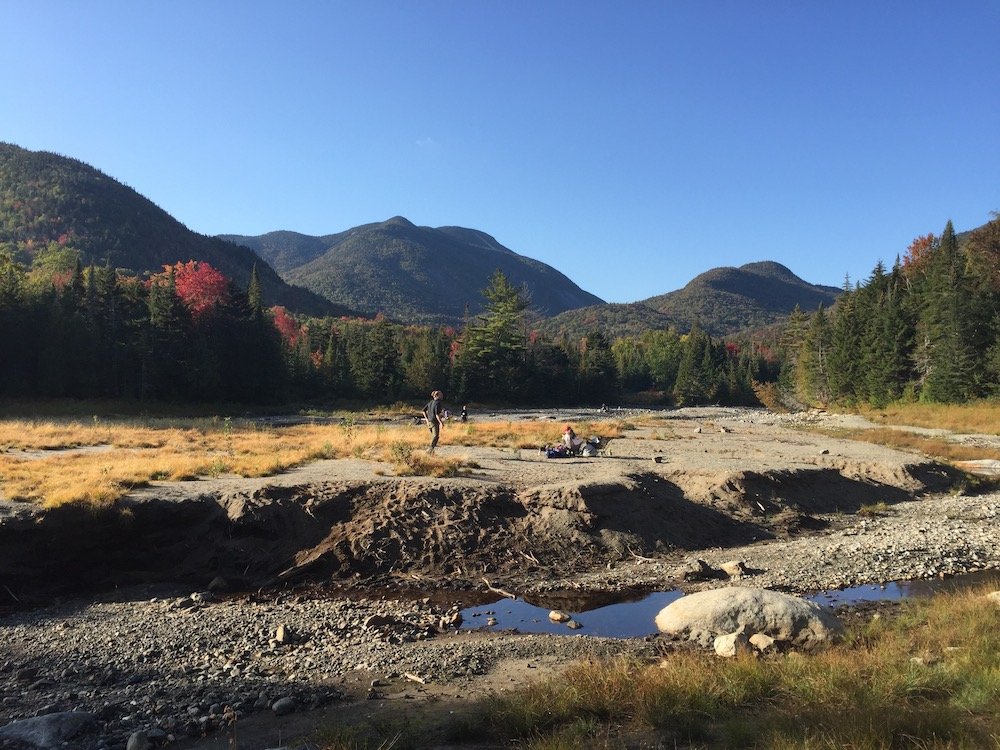Case Study: Adirondack Park
Managing recreation impacts and creating a culture of stewardship in the Adirondack Park
Adirondack Park | Marcy Dam Trailhead
Overview
The Adirondack Park was created in 1892 by the State of New York, essentially creating the largest publicly protected area in the contiguous United States. Of the Adirondack Park's 6 million acres, 2.6 million acres are owned by New York State. The remaining 3.4 million acres are privately owned. The Park is also home to over 100 villages and towns. One thing that sets the Adirondack apart is the park’s mix of public and private land which allows for conservation and civilization to flourish.
Forest Preserve land comprises a significant portion of the Adirondack Park – 2.6 million acres. Forest Preserve land has specific regulations and land use codes, meaning the land is designated as “Forever Wild” under the New York State Constitution, Article XIV. Forever Wild land is designated “to preserve the exceptional scenic, recreational, and ecological value” in perpetuity. This level of protection from the State ensures that resource protection will be prioritized, and that lands will offer exceptional recreational opportunities. The state-owned lands in the Park consist of historic, wilderness, canoe, primitive, wild forest, and administrative lands. Of the remaining 3.4 million acres in the Park, they are privately owned (towns, villages, businesses, and farms), and the use of these lands is overseen and regulated by the Adirondack Park Agency.
The Park boasts 30,000 miles of streams and rivers as well as 3,000 lakes and ponds, making it ideal for water-based recreation including paddling and angling. Furthermore, there are 46 mountain peaks in the Adirondacks that are over 3,900 feet in elevation. These are known as the High Peaks. The highest of the High Peaks is Mount Marcy, which is also the tallest peak in the state at 5,343 feet. Backpacking and hiking are popular in the Park which offers more than 2,000 miles of trails. Recreation occurs year-round in the Park including cross country and downhill skiing, snowmobiling, and snowshoeing during the winter months. Due to the Park’s proximity to 60 million people, it draws visitors from across the region.
Adirondack Park | Marcy Dam Trail
The Problem
Though the Park has been popular for many years, it has experienced explosive growth in visitation over the past few years. Due to its porous nature, determining exact visitor numbers annually is challenging. However, those charged with managing the park indicate annual visitation is estimated to be between seven and twelve million. With that visitation comes some level of impact. Managers and key partners have noted specific impacts of concern including: overuse and crowding, trail degradation and erosion, human and pet waste, parking issues, and unprepared visitors.
Defining and better implementing a new recreation standard for park visitors will only be increasingly important in the years to come. Park managers and key partners need to address expectations for public use in parallel with protecting the vital natural and cultural resources found in the Park. Visitors need a clear understanding of how to enjoy the Park responsibly, now and in the future.
Adirondack Park | Marcy Dam
The Solution
The project involved collaborating with two key advocacy organizations in the Adirondacks to provide a park-wide assessment, which included the following components:
Consultation with the Adirondack Council and the Adirondack Mountain Club to gain baseline understanding of recreation-related issues facing the Adirondack Park;
Administration of an online survey to Adirondack Park managers, key partners, and others to collect data on recreation trends, recreation patterns, pressing recreation-related issues, significant impacts from recreation, and strategies currently being utilized to address these concerns;
On-site visit in conjunction with Council and ADK staff to explore and observe current park conditions, meet with key Park management staff from both the NY Department of Environmental Conservation and the Adirondack Park Agency and other stakeholders, and to acquire a solid understanding of how effective visitor use management strategies could be effectively and efficiently overlaid on and deployed in the Adirondack Park to solve its most pressing issues;
Creation of comprehensive assessment report including specific and targeted recommendations for solving the Park’s most critical visitor use issues.
“Given the size and complexity of the Adirondack Park, this was one of the most interesting and challenging projects I’ve worked on,” said Lawhon. “With so many stakeholders and such a long list of critical issues facing the Park, it was clear that a comprehensive approach to solving the issues was warranted,” he says.
One of the key reasons the Adirondack Council and the Adirondack Mountain Club wanted to work with Lawhon was because of the vast experience across the park and protected area spectrum he brings to his projects. Lawhon uses a multi-faceted approach to quickly assess, understand, and provide realistic and effective solutions for addressing visitor use issues. “I was able to see most of the Park’s hot spots during my three-day site visit, and acquired a solid understanding of the various issues and key stakeholders involved,” said Lawhon. As he toured the Park, Lawhon was able to develop a suite of targeted recommendations that were included in the formal assessment report to the Adirondack Council and the Adirondack Mountain Club.
According to the Executive Director of the Adirondack Council, William Janeway, the organization was very pleased that the New York State working group for the Adirondacks recommended immediate actions to curb the overuse and overcrowding on the Forest Preserve, embraced the 52 recommendations provided by Lawhon, and suggested better data collection for long-range planning.
Adirondack Park | Upstream Marcy Dam View
Included in the 52 recommendations were the following:
Improved data collection on both resource and social conditions to allow for measuring changes over time
Conduct ongoing social science research on park visitors for a deep understanding of motivations, attitudes, beliefs and perceptions
Provision of consistent and coordinated visitor education and outreach, including Leave No Trace, park-wide
Development of a park-wide social media strategy to ensure broad collaboration and consistency
Enhancement and further use of shuttle systems to alleviate traffic, parking, and roadside safety issues for visitors
Ensuring a qualified pool of agency staff, NGO staff, and volunteers that can make effective public contacts with visitors about responsible recreation
Though visitation to the Adirondack Park is likely to continue increasing, the plan provided by Lawhon will serve the Park well into the future. One of the key attributes of the plan is the evergreen nature of the recommendations. While some were time-sensitive or time-bound, the vast majority are things that Park managers can do in perpetuity to ensure long-term sustainability of the Park.





